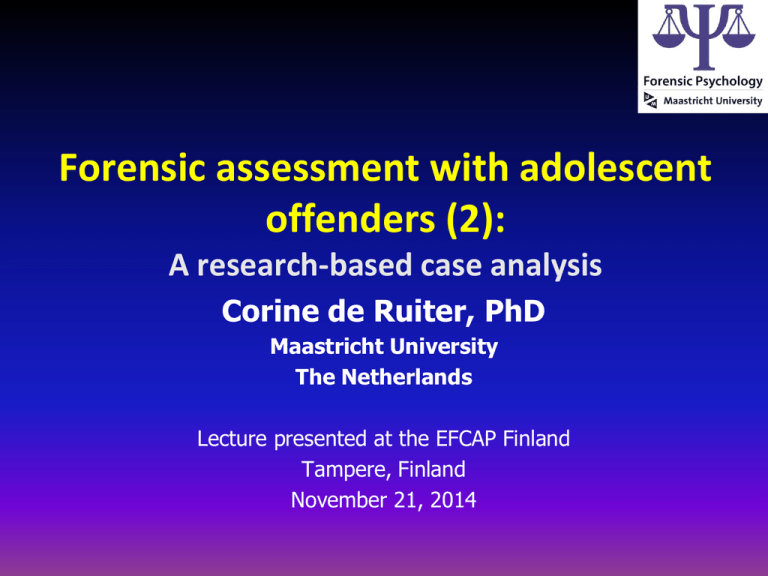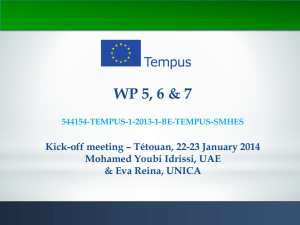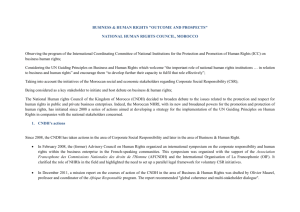A case illustration
advertisement

Forensic assessment with adolescent offenders (2): A research-based case analysis Corine de Ruiter, PhD Maastricht University The Netherlands Lecture presented at the EFCAP Finland Tampere, Finland November 21, 2014 A case illustration-Samir History (1) • Born in Morocco, migrated to The Netherlands at age 11 • Goes to a Dutch school; knowing no Dutch at first • Very homesick, feels isolated • Concentration difficulties, oppositional behavior • Father (an Imam) has high expectations of him, no emotional bond A case illustration-Samir History (2) • Sent to a boarding school; vocational training to become a plasterer • Is forced to move, and loses his internship position • No diploma, no income • Meets friends; Samir claims they came up with the idea to rob video stores and cafeterias • 13 robberies in 3 weeks, before his 18th birthday A case illustration-Samir First Trial (1) • Samir is examined by a psychologist and a psychiatrist • Both conclude: • Conduct Disorder, with beginning Antisocial PD; psychopathic traits • Advice to adjucate him in adult court (“mature”) • High risk of recidivism • Verdict: 6 years imprisonment A case illustration-Samir Second Trial (2) • Court of Appeal commissions new forensic assessment (second opinion) • In January 2011, I examine Samir • Another child psychiatrist is also commissioned to write a forensic report A case illustration-Samir Second Trial (2) • Forensic psychological assessment: • MMPI-2 • Psychopathy Check List: Youth Version (interview + extensive file information, including the two previous forensic reports) • Structured Assessment of Violence Risk in Youth (SAVRY) • Information from the juvenile justice institution where he has been admitted since his arrest (information from mentor, treatment progress notes) A case illustration-Samir Psychological test findings (MMPI-2) -open response style -31 codetype: inhibits emotions -Psychosomatic complaints (headaches) -authority problems, but no antisocial attitudes -fear of social rejection, conflict avoiding -extravert; likes to be around people A case illustration-Samir Psychological test findings (PCL:YV) • PCL:Youth Version: 20th percentile among juvenile offenders • Low on CU traits Collateral information sources • Mentor: Samir is actively involved in his school work • He is learning to talk about his feelings more • Group treatment (aggression regulation training; social skills training): adequate participation A case illustration-Samir Psychological test findings (SAVRY) -History of violent and nonviolent Offending -Past supervision failure A case illustration-Samir Psychological test findings (SAVRY) Stress and poor coping Poor parental management A case illustration-Samir Psychological test findings (SAVRY) Notable absence of individual risk factors A case illustration-Samir Psychological test findings (SAVRY) -Notable absence of individual risk factors -Presence of protective factors: Prosocial involvement during leisure activities Positive attitude towards intervention A case illustration-Samir Psychological test findings (SAVRY) -Notable absence of individual risk factors -Presence of protective factors: Strong commitment to school Conclusions of the assessment: Moderate risk •Samir’s recidivism risk seems highly situationdependent, i.e. linked to his financial problems •His criminal behavior is mainly related to peer delinquency, poor coping skills, lack of parental guidance/support •Samir does not endorse any antisocial attitudes; experiences remorse •Protective factors: commitment to school, future plans, structured leisure activities (sports teams) Crosscultural aspects • The move to The Netherlands at the beginning of his adolescent years seems to have led to adjustment problems, including internalizing and externalizing behavior problems. • The strained relationship with his father, including the high expectations for his (second) son, may have been exacerbated by the strong pressure to conform in a collectivistic culture. Research on delinquency in Moroccan youth in The Netherlands • What is known from empirical research about disruptive and antisocial behavior problems in Moroccan adolescents in The Netherlands? • Are the causal and risk factors similar to those found in Dutch adolescents? • What do we know about the possible influence of cultural factors in cases like Samir’s? Research on delinquency in Moroccan youth in The Netherlands • Moroccans belong to one of the largest immigrant groups in The Netherlands. In 2012, about 363,000 Moroccans lived in the Netherlands, which is 2.2% of the total population. • Their mean age of 27.8 years suggests a group with predominantly young people. In comparison, the mean age of the Dutch people is 41.4 years (Nicolaas, Loozen & Annema, 2012). Research on delinquency in Moroccan youth in The Netherlands • Of all criminal suspects, 5.2% come from the Moroccan group. R • ecidivism rates are highest among Moroccans: eight out of 10 juveniles and seven out of 10 adult Moroccans recidivate (Jennissen & Besjes, 2012). • BUT: studies using self-report measures do not find significant differences in antisocial problem behavior between different ethnic groups (Dutch, Turkish, Moroccan, Surinamese; Deković, Wissink, & Meijer, 2007). • Possible explanations: (1) ethnic bias of police, (2) socially desirable responding Research on delinquency in Moroccan youth in The Netherlands • Based on parent and teacher ratings, compared to Dutch boys, Moroccan boys (5-12 yrs) were about 70% more likely to display problem behavior (ADHD, ODD, CD; Zwirs, Burger, Schulpen, & Buitelaar , 2006) • Moroccan parents showed low levels of problem perception: only 47% of the Moroccan parents recognized problem behavior in their 5-6 year old children, in contrast to 81% of the Dutch parents (Bevaart et al., 2012) • Gender-specific parenting in Moroccan culture, which confronts Moroccan boys with a harsh authoritarian socialization in the home but with a lack of supervision from their parents outside the home. Research on delinquency in Moroccan youth in The Netherlands Are risk factors for antisocial behavior (ASB) similar for Moroccan immigrant children compared to native Dutch children? • Yes: family problems, low parental monitoring and affection, deviant peer involvement, learning problems predicted ASB (Stevens, Vollebergh, Pels & Crijnen, 2005) • Perceived discrimination also predicted externalizing behavior problems in Moroccan youth Research on delinquency in Moroccan youth in The Netherlands Acculturation as a risk factor • Closer proximity to Dutch culture predicted reoffending in Moroccan youth (Paalman, van Domburgh, Stevens, & Doreleijers, 2011) • Incarcerated Dutch-Moroccan adolescent boys were more orientated toward Dutch society compared to a control group of non-offending Dutch-Moroccan boys (Veen et al., 2011) Application of the research on Moroccan adolescents to the case of Samir • His father is an imam: high significance placed on traditional Muslim values; father also has high expectations of Samir; lack of warmth (Stevens et al., 2007) • Parental rejection when Samir had his first arrest (for theft); lack of parental monitoring • Perhaps there was also a conflict of values between father and son (Samir went out on the town with friends; father is very strict) Psychiatric Classification according to DSM-IV-TR • Axis I: Conduct disorder, starting in adolescence • Axis II: Problems in the father-child relationship • Axis III: Frequent tension headaches • Axis IV: Incarceration, awaiting trial in Court of Appeal, acculturation-related stress • Axis V: Global Assessment of Functioning (current= 60) Verdict Appeals Court First verdict was upheld: 6 years imprisonment (adult criminal law) Recidivated within a year of release Again imprisoned (Summer 2014) New Book, Coming in February 2015 www.corinederuiter.eu










